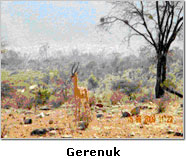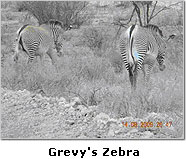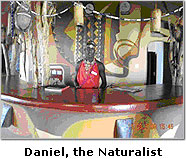The Song of the Samburu
 |
September, 2009
By Ilmas Futehally
|
Soon after the workshop on Climate Change and Water Stress in the Eastern Himalayan River Basins in Kathmandu, I left on a family holiday to Kenya. This was the African Safari we had been dreaming about…. seeing the Big Five, apart from giraffes, zebras, hippos…. Little did I think that climate change and water stress would continue to occupy my thoughts.

Our first stop, Samburu National Reserve in Northern Kenya lies in a semi arid desert that extends all the way to Ethiopia. Unique to this region are a number of animals, which include the Grevy’s Zebra (delicately patterned), the reticulated giraffe, oryx, gerenuk (with its long neck reaching out to the higher branches, one can almost see natural selection in action) and the truly majestic Somali ostrich. The people of Northern Kenya, the Samburu, cousins to the better known Southern Maasai, are warrior nomads often seen tending their livestock and cattle along the dusty trails in the park.

The first couple of sojourns into the reserve left us gasping for breath at the profusion of animals that we saw. Then a Samburu naturalist, a.k.a. Daniel gave us a talk on the region. He spoke about climate change and how it is affecting the Samburu lands. In the last two years, the rains have failed them 5 times. There has not just been less rain; in the last session of long rains (April-May 2009) they had no rain at all. “I believe it’s due to something called global warming”, said Daniel, “we are seeing it happen before our eyes.” Daniel himself has seen his herd of cattle dwindle from 50 to 10 in the last few months. If the short rains in the end of October do not arrive, he expects all the livestock to die.

For the Samburu people, their cattle is their wealth and the social system is based on exchange of cattle. The decline in cattle population affects the health of the communities, as malnutrition and disease sets in, as the Samburu, are highly dependent on the blood, milk and meat of their livestock for food. Parents cannot marry their children off if they do not have cattle. A boy cannot attain manhood if he does not have cattle. Attendance in schools is declining as families move further and further away in search of fodder and access to heath centers. There is also talk of rising tensions between the different communities over scarce resources.
Some species of wild animals in the reserve are doing slightly better at present, as they are more adapted to the dry land conditions and occasional drought. In fact, at present the scavengers are doing particularly well with the high rate of death among domesticated livestock. However, it is expected that the zebras, the giraffes and the gerenuk that we saw will also start to perish if the next round of rains at the year end do not arrive in time.

Looking at the longer term is also not very encouraging. Climate change models have predicted that drought in the pastoral lands of Africa will double by the end of this century, and that while the number of drought periods may not significantly increase; they are likely to last for longer, making recovery more difficult.
We went on to our next stop, Lake Nakuru National Park in the Rift Valley area to see a multitude of flamingoes. Later we did see the Big Five as well…. a truly exhilarating experience. But the images of the Samburu lands and its current plight remain deeply etched in my mind. Will the Samburu people be able to overcome the current crisis or will the song of the Samburu be silenced forever?
Related Publications
-
.jpg&maxw=50)
Big Questions of Our time: The World Speaks, 2016
Download:Big Questions of Our time: The World Speaks _Full Report
-

-

Second Freedom South Asian Challenge 2005-2025, 2005
read more
Download:Second Freedom South Asian Challenge 2005-2025 Full Report
Related latest News
Related Conferences Reports
-

Global Challenges Conference, October 2016
Download:Global Challenges Conference Report
-

Conference on Responsibility to the Future: Business, Peace and Sustainability, June, 2008
Download:Global Security and Economy: Emerging Issues


